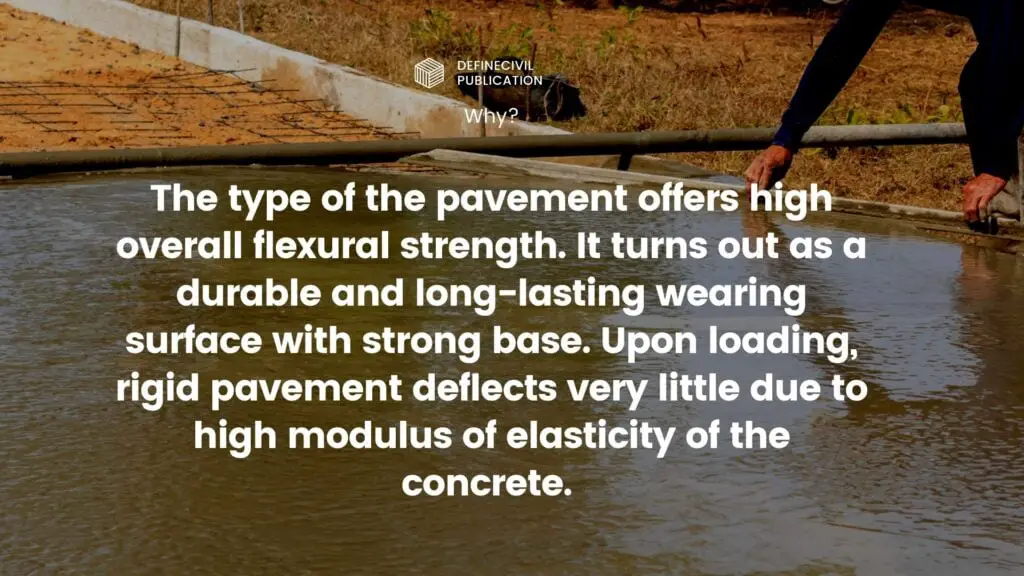So, when you step in the world of pavements, you’ve got two broad classes or types’ i.e. rigid pavement and flexible pavement. So, what is rigid pavement and what is the difference between flexible and rigid pavement?
In simple terms, we can say that a pavement made with concrete acts like a rigid pavement while the type of pavement made with asphalt acts like a flexible pavement. Both have their own pros and cons and have specific uses. So, as a civil or transportation engineer you need to decide one type keeping in view the traffic conditions as well as the foundation or subgrade.

Difference between flexible and rigid pavement
When you’re looking to choose a type of pavement for your project; you’re left with two options either to choose a flexible pavement or a rigid pavement.
You might already know that a rigid pavement is that of a concrete pavement where as a pavement in layers with asphalt as top wearing layer is a flexible pavement.
But that’s not tall. There’re number of ways how flexible pavement differs from rigid pavement.
So, our today’s amazing article is about the difference between flexible pavement and rigid pavement?
Also Read: Rigid Pavement- Types – Stresses
Composition
The two pavements differ a lot in terms of their composition. So, what’s that?
Well, flexible pavements are composed of properly graded aggregates with bitumen or tar as a binder.
Whereas a Rigid pavements are constructed by using PCC – cement, aggregate, water, and dowel bars for joints.
Loading
Do you know how both pavements behave under loading?.
Well, a flexible pavement takes load based on interlocking of aggregates, friction, and cohesion. It acts as a flexible material under-loading.
On the other hand, a rigid pavement takes loading due to its flexural strength of concrete. It acts rigid under loading and doesn’t deform on load.
Suitability in terms of traffic
If you’ll look at the suitability of the road you’ll see a whole lot of difference.
A flexible pavement is not good to support heavy truck loadings. That’s why in motorways there’s always a weight check for the heavy traffic.
On the other side, for trucks and heavy traffic; there’re separate lane that is made with rigid pavement.
Design and Construction
Both pavements differ in terms of design and construction.
Flexible pavement includes number of layers from subgrade, sub-base, base, and wearing layer. The layers help in transferring the impact of loading over a larger area.
Rigid pavement doesn’t go like this. It only has one layer of concrete slab that sits atop of the subgrade. For slabs with reinforcement, you may have an additional layer of lean concrete to have a flat surface for rebar installation.
Also Read: Water Bound Macadam Road – WBM – Base Course – Specification- Procedure
Construction Procedure
Another difference in construction procedure includes the provision of joints.
Well, a rigid pavement can’t resist temperature forces like shrinkage and expansion. That’s why we provide lateral and cross-joints in road. Do you know we also provide dowels so the load can travel from one panel to the other.
But Wow! there’s no such hassle in flexible pavement. You take the paver and lay a continuous stretch of road without having to worry about the damn temperature forces.
Maintenance
Let’s now see how you need to plan for maintenance of both roads?
Well, for a rigid pavement; the initial cost is more. Concrete is a costly item; with added cost of dowels and joints. Moreover, the construction take a bit of more time and is also complex.
For flexible pavements, the initial cost is less but damn! – the maintenance is too much. You need to overlay or patch the road as a result of natural wearing. It loses the shine and the aggregate may loose the adhesion of asphalt.
Time to wait before traffic
Do you know – how much time you need to wait, before letting traffic use the pavement?
Well, a flexible pavement is able to take traffic loading only after 24 hours. But you can’t even walk on a rigid pavement after a day. In fact, you need to wait for 14 days to let the concrete cure. That’s because of the entire curing mechanism of concrete.
Riding Quality
Another important difference between rigid and flexible pavement is the riding quality.
When you take your car on a flexible pavement, you can’t feel any jerks or vibration in your car. There’re no joints no bulges or whatsoever. You can even place a cup of tea on your dashboard without worrying for it to spill. So, flexible pavement is smooth and awesome.
But damn – the rigid pavement. You drive on a rigid pavement; and you’ll feel the poor riding quality. There’re jerks and motions; you can’t stay still there buddy.
Construction Process
Let’s now see how both differs in terms of construction process.
Well, till the compaction of subgrade – the steps are same. But for flexible pavement, you place subbase and base layer of water bound macadam. Then you spread stone dust on the top and let the vehicles run on the ramp to have compaction. At the end you take paver and pave asphalt in lengths.
But for rigid pavement, you apply the formwork, insert dowels and ties along the formwork. Clean the subgrade, and pour the concrete into the formwork. Let the concrete cure by ponding and then make cuts for control joints and expansion joints.

The above infographic shows the types of bitumen for different types of flexible pavements. The above inforgraphic is proudly shared by infinitygalaxy.org.
When rigid pavement is preferred over flexible pavements?
Rigid pavements provide very poor riding quality and are only used in special requirements. Flexible pavement, on the other hand, provides high riding quality but has reduced life and needs maintenance. Following are some adverse conditions that require us to choose rigid pavement over flexible pavement:
- Higher intensity of the precipitation/ heavy rainfall
- The condition of soil is not supporting and very poor soil underneath (low bearing capacity)
- The drainage quality is very poor (asphalt pavement doesn’t stand well in stagnant water)
- Climatic conditions are extremely unfavorable
- Shallow water table
- Higher moisture content in the base and surface courses
- There’s a need of minimal maintenance
- The loading conditions don’t suit flexible pavement
Flexible pavements deflect under heavy loads and so they’d be of no use in conditions of heavy loading and low-bearing soils. Similarly, drainage plays an important role in durability of the flexible pavements. But if you can’t control the stagnant water due to heavy rainfall or the underground water table, it’s better to choose rigid pavement.

See Also: What is a culvert? – Definition – Types – Materials – Parts.
DIFFERENCE BETWEEN FLEXIBLE AND RIGID PAVEMENT
| Flexible pavement | Rigid pavement |
| Not suitable for the heavy loads and weathering conditions | Suitable for the heavy loads and weathering conditions |
| Load distribution is not uniform | Load distribution is uniform due to rigid slab |
| Temperature variation do not affect the stress distribution | Temperature variations affect the distribution of the stress |
| Skilled supervision and labor are not required for the construction | Skilled supervision and labor are required for the construction |
| Easier to locate perform underground works | Difficult to locate and perform underground works |
| Bearing capacity of sub-grade affect the design | Bearing capacity of sub-grade do not affect the design |
| Aggregate and asphalt is used as construction | Steel and concrete used for construction |
| Constructed in different layers | It is also called as single layer pavement |
| It is capable resisting the settlement | The settlement is done permanently |
| Its repairing is easy, but maintenance cost is high | Its repair work is difficult and maintenance cost is low |
| It does not require any curing and can be used for traffic shortly | It requires curing and cannot be used for traffic shortly |
| Poor visibility at night but don’t glare in the sunlight | Appreciable visibility and provide glare in the sunlight |
| Its thickness is greater and rolling of surface is needed | Its thickness is lessor and no rolling on surface is required |
| It has low flexural strength and force of friction is lessor | It has higher flexural strength and appreciable force of friction |
| It is sensitive to organic material (chemicals) | Not much sensitive to organic materials (chemicals) |
| Initial cost of construction is low | Initial cost of construction in more |
| It does not require any joints for construction | It requires joints for construction |
| It is less durable, and strength is lessor | It is durable and much strength |
| It is more comfortable for travel | It is less comfortable for travel |


















